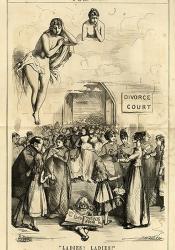The Matrimonial Causes Act of 1857
Group 3 Marriage Entry 2
During the nineteenth century, obtaining a divorce was difficult and frowned upon in society. The Matrimonial Causes Act of 1857 helped men and women obtain divorces but the process was still unequal. In the article, “Marriage in the 19th century,” John Simkin notes: “The Matrimonial Causes Act of 1857 gave men the right to divorce their wives on the ground of adultery. However, married women were not able to obtain a divorce if they discovered that their husbands had been unfaithful.” The only grounds a woman could obtain a divorce on was by proving that her husband had been unfaithful AND cruel. This imbalance made marriage a societal convention that leaned toward male authority and domination. In 1857, Parliament believed that wives who committed adultery could break families by introducing offspring from an affair which made their offense of adultery more serious than men’s. This excuse played upon the reproductive elements of women which they sought to believe should act as a deterrent for women. Men did not have to abide by these beliefs and could break the contract of their marriage by having clandestine affairs. The legality and economics of marriage favored men which never fared well for women.
This complex presentation of divorce within 19th century marriage law is strongly presented in Jane Eyre through Mr. Rochester and Bertha. Mr. Rochester, though legally married to Bertha, seeks both a relationship and marriage with Jane Eyre. Bertha, his lawful wife, is confined in a locked room on the third floor of Mr. Rochester’s house, with no interaction with anyone other than her caregiver Grace Poole. While Bertha is trapped within cruel conditions, her husband seeks new relationships and love, both of which would fulfill the Matrimonial Causes Act of 1857 as grounds for her divorce. Yet, the act has not yet been passed and so she is confined to this permanent isolation and unable to ever escape her marriage. Even so, Brontë makes sure to depict Bertha as a savage and insane character, who acts more animalistic than human. Brontë states, “What it was, whether beast or human being, one could not, at first sight, tell: it grovelled, seemingly, on all fours; it snatched and growled like some strange wild animal…” (Brontë 338). This depiction of Bertha may have served to only further Brontë’s commentary on gender inequality by portraying Bertha in such a way to further oppress her. Unsurprisingly, researcher Kate Summerscale notes how medical manuals of the time contributed women’s sexual desire to insanity. Perhaps then Brontë was not merely making Bertha the image of a “madwoman” but instead creating the married woman who has all the reasons to become divorced and be free of the tyrannical rule of her husband, but is cast aside and labeled insane for simply having the same drive to pursue sexual desires as her husband. Thus, Brontë seems to use Bertha as a symbol of the issues with marriage laws of the time and how even within harsh and cruel conditions, those of which would later be fully legal grounds for divorce, Bertha remains powerless to the power Mr. Rochester has over her and himself. In fact, it is only Jane Eyre herself who refuse to marry Mr. Rochester in accordance with the laws of marriage, permitting only one wife at a time. Brontë’s depiction of the relationship between Mr. Rochester and Bertha therefore shows the issues that pushed 19th century England to establish laws like the Matrimonial Causes Act of 1857. Though this law did not make it possible for any women to obtain a divorce easily, it did start to pave the way for future equality in marriage and served as a direct answer to women’s anxieties concerning marriage as seen almost ten years prior in the work of Charlotte Brontë.

Bibliography
Bailey, Martha.“The Marriage Law of Jane Austen's World " JASNA, 2015, http://www.jasna.org/publications/persuasions-online/vol36no1/bailey/
Brontë, Charlotte, and Stevie Davies. Jane Eyre. London: Penguin, 2007. Print.
UK Parliament. “Divorce.” UK Parliament, www.parliament.uk/about/living-heritage/transformingsociety/private-live...
Simkin, John. “Marriage in the 19th Century.” Spartacus Educational, Spartacus Educational, Jan. 2020, spartacus-educational.com/Wmarriage.htm.
Summerscale, Kate. “Kate Summerscale: Victorian divorce law rested on a double standard.”
Youtube, uploaded by Bloomsbury Publishing, 1 May 2012, https://www.youtube.com/watch?v=lI1pLKw8V3E&feature=emb_title
Additional Links:

